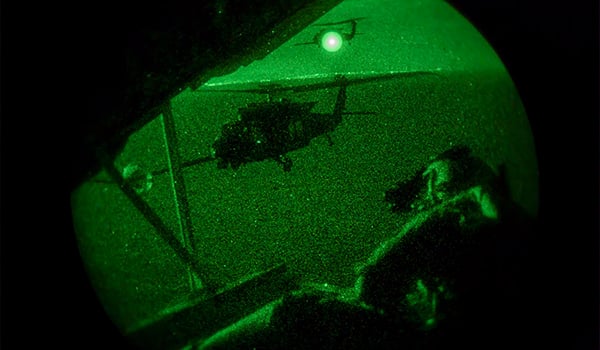
Branch Chief’s Corner / By MG David J. Francis: In the 40 years since Desert One and Operation Eagle claw, U.S. Special Operations Aviation (ARSOA) has led Army Aviation in the development of capabilities and tactics, techniques and procedures that are used throughout the Aviation Branch today.

In the 40 years since Desert One and Operation Eagle claw, U.S. Special Operations Aviation (ARSOA) has led Army Aviation in the development of capabilities and tactics, techniques and procedures that are used throughout the Aviation Branch today. / U.S. MARINE CORPS PHOTO BY CPL. CARLOS JIMENEZ
ARSOA’s OPTEMPO remains high, with every Combatant Command (COCOM) persistently requesting these units’ unique capabilities. Capabilities that provide the joint force a range of options, including multi-national exercises and conducting multilateral or unilateral special operations with absolute precision. Moreover, the unique capabilities of ARSOA will be invaluable in Large Scale Combat Operations (LSCO). They will have a key role in penetration, dis-integration, and exploitation for our maneuver forces in multi-domain operations (MDO). We must continuously learn, anticipate and evolve to address the known and uncertain threats in a multi-domain environment. Over the next decade-plus, we will face complex challenges that will test the mettle of Army Aviation Special Operations and our Combat Aviation Brigades.
Future Operating Environment
Based on our National Security Strategy, threat studies, and extensive modeling, we can characterize future adversaries as having technologically advanced intelligence-enabled battlefield networks. We also know forms of conflict in the future are likely to be hybrid, blending conventional and irregular capabilities. As an enterprise, we must maintain a portfolio of complementary capabilities across the spectrum of conflict, understand the aspects of hybrid conflict and codify doctrine for these operations to counter hybrid threats. We must develop intelligence collection, analysis, and synthesis capabilities, to understand indicators or warnings for gray zone threats. To ensure that we can defeat tomorrow’s enemy, Army Aviation, including ARSOA, moves forward with a deliberate plan to ensure our force is relevant for 2030 and beyond. These capabilities include the next generation of army aircraft, extended range munitions, and unmanned aerial systems capable of decisive operations in the lower tier air domain.
ARSOA and LSCO
Interdependence, interoperability, and integration between conventional forces and special operations across the Total Army complement strategic readiness and leads to decisive action. Operationally, we have seen the benefit of integrating aviation to meet COCOM requirements leveraging the strengths of each organization. Our success in integration over the past decade-plus include COCOM joint exercises, combat training center rotations, and warfighter exercises. For MDO, we must understand the complementary aspects of training, material, leadership, and personnel policies between Army Aviation and ARSOA.
As we move towards MDO, Army Aviation must continue to integrate Special Operations Aviation to enable operational-level maneuver options. FM 3.04 is the foundational doctrine for aviation and includes the planning factors and nuances of coordinating with and employing Special Operations Aviation. Converging Army Aviation and ARSOA capabilities across multiple domains optimize our employment capabilities to attack critical components of the enemy’s anti-access and area denial systems, specifically long-range air defense and fires networks. It is this convergence against the enemy’s long-range systems that enables the initial penetration. As an aviation force through common doctrine, we succeed by integrating our capabilities.
Our Institutional Training is rapidly converting to LSCO to provide the baseline for all leaders and aviators. While our special operations aviators and units undergo well-resourced and unique training requirements, we share and have a mutual interest in keeping our aviators abreast with emerging doctrine throughout their careers.
Our FVL effort will improve the speed, range, survivability, lethality, and sustainment of both our special operations and our conventional fleet. The design of FVL is to employ targeting processes/systems that maintain an asymmetric advantage over adversaries and avoid or mitigate detection and geolocation in denied, semi-permissive, and permissive environments. FVL will not only penetrate the enemy’s IADS, but will also restrict enemy freedom of action, present multiple dilemmas to the enemy, and extend tactical commanders’ understanding through the depth of the operating environment. FVL requirements and designs include special operations subject matter experts’ input to ensure these platforms meet mission requirements across the entire spectrum of our aviation forces.
Leader development includes providing ARSOA and Army Aviation with multi-domain leaders and Soldiers that are resilient, can operate in highly contested operational environments, and can conduct independent maneuver and employ fires. We must holistically develop our leaders across the enterprise for the rigors of LSCO.
Personnel demands are high across all COMPOs of aviation. ARSOA’s OPTEMPO demands a healthy structure to provide depth and flexibility for the numerous time-sensitive missions found across the COCOMs. We know the broader aviation enterprise feeds the special operations aviation pipeline providing our aviators an opportunity to join special operations contributing to their Nation through a unique mission profile.
Our modernization and integration of Special Operations with the Total Force provide our Nation strategic depth and flexibility. We must continue to resource Army Special Operations Aviation to fulfill the current operating environment’s requirements, mature and modernize the force to meet mid-term demands, and invest in future unique capabilities not found elsewhere in the Army or the DoD. Regardless of the environment, the constant is that ARSOA operations are executed by highly trained, rapidly deployable, and scalable formations that buy time and space for commanders. ARSOA capabilities allow aviation and the Army to keep a promise to our Nation – to protect the Nation without fail and without equal.
Above the Best!
MG David J. Francis is the Army Aviation branch chief and commander of the U.S. Army Aviation Center of Excellence and Fort Rucker, AL.








